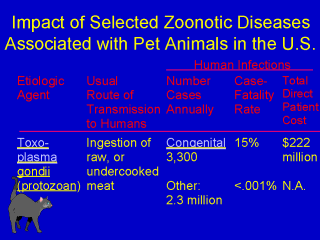Search for most updated materials ↑
|
|
|
|
front |1 |2 |3 |4 |5 |6 |7 |8 |9 |10 |11 |12 |13 |14 |15 |16 |17 |18 |19 |20 |21 |22 |23 |24 |25 |26 |27 |28 |29 |30 |31 |32 |review |
 |
Infectious agent: Toxoplasma gondii, a coccidian protozoan. Occurrence: Worldwide, in mammals and birds. Human infection is common. Reservoir: Definitive hosts of T. gondii are cats and other felines. Intermediate hosts of T. gondii include sheep, goats, rodents, swine, cattle, and birds. Mode of transmission: By eating raw or undercooked infected meat containing tissue cysts, or by the ingestion of infective oocysts in food or water contaminated with feline feces. Transplacental infection in humans occurs when a pregnant woman has rapidly dividing tachyzoites (a form of the parasite) in the bloodstream. Children may become infected by ingesting infective oocysts from dirt in sandboxes, playgrounds, and yards in which cats have defecated. Incubation period: From 5 to 20 days. Methods of control and prevention: Cook meats to 150 degrees F. before eating. Education and sanitary practices concerning handling of raw meats. Wash hands thoroughly before eating and after coming in contact with soil and cat litter pans.
See pages 468-471 in Control of Communicable Diseases Manual for more detailed information.
|